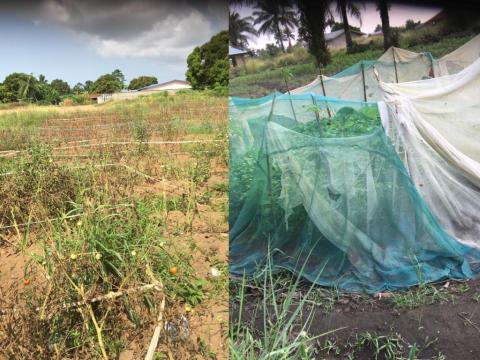By Kemo Cham and Kadijatu K. Hayles
A green scenery across part of Masoila, a community in the Kaffubollom chiefdom of Port Loko, makes a remarkable geographical beauty.
Underlying this beauty are plush gardens across the settlement, the lifelines of many families in this part of the northern Sierra Leonean district, who grow vegetables like tomatoes and pepper.
But this entrepreneurial agricultural venture is being undertaking at a huge personal cost to the well-being of the population. An increasing number of the gardeners use bed nets, tied around the perimeters of their gardens, as protection against animals, insects and other pests.
Bed nets are supposed to be used as protection for humans against mosquitoes, the vectors of the parasite that causes malaria, a top killer disease in Sierra Leone.
The World Health Organization (WHO) considers bed nets as the most effective preventive measure against malaria. They serve as protective barrier around people while they are asleep under them.
Studies have shown that insecticide-treated bed nets reduce malaria illness, severe disease, and death due to the parasitic disease in endemic countries like Sierra Leone, where it accounts for most illnesses and deaths among children.
Over the decades the use of insecticide treated bed nets has evolved, with the discovery of effective chemicals that not only kill mosquitoes and other insects, but also repel the insects and reduce the number that enter the house and attempt to feed on people inside.
According to the United States Centers for Diseases Control and prevention (CDC), if high community coverage of use of insecticide treated bed nets is achieved, the numbers of mosquitoes, as well as their length of life will be reduced, thereby making all members of the community protected, regardless of whether or not they use a bed net.
The world has long moved on to using long-lasting insecticide-treated nets, which maintain effective levels of insecticide for at least 3 years, even after repeated washing.
The Sierra Leone Government and its development partners spend thousands of US Dollars to procure these lifesaving commodities on average every two years. The distribution is done in three different ways: during mass campaigns; when a pregnant woman registers for antenatal clinic; and during routine immunization of infants.
But this distribution process has been constantly shrouded in controversy, especially during the mass campaigns, amidst allegations of bribery and corruption against health officials who handle the process. Reports of bed nets going missing are common.
Some people believe that corruption may as well be aiding the misuse of the nets, because while some people are unable to secure even one, others, like Lawrence Bangura, can secure more than they need, at minimal cost.
Lawrence, who lives in Masoila, has two pieces of bed nets at home - one for himself and his wife and the other for the kids – and at least one at his garden.
Lawrence grows tomatoes. In one part of the garden, the nets are tied around the plants. On another portion of the garden, he shreds the nets into tiny pieces of ropes, which he uses to hold together the fragile tomato seedlings.
“The nets prevents my tomato seedlings from the direct down pour of rain. And the ones I used as ropes prevents the seedlings from breakage,” Lawrence explains to KMN’s Kadija Kargbo in an interview at his garden.
While declining to disclose how he got the nets he uses at the garden, Lawrence says he is well aware of the implication of his action of using the nets for the wrong purpose, promising to desist from doing so going forward.
But misuse of bed nets is by no means isolated to Port Loko District. Reports indicate that the phenomenon cuts across the country.
Bed nets are a valuable commodity in fishing communities, where they are used not just by the fishermen but also women fishmongers in the process of preserving the fish.
In Konakry Dee, a fishing community in the Mayaya Section, also in Kaffubollom, female gardener Fatmata, who declined to share her surname, uses the nets to keep insects away from her pepper seedlings. She says she relies on nets because she cannot afford to buy insecticides.
According to the National Malaria Control Programme (NMCP) of the Ministry of Health and Sanitation (MoHS), Sierra Leone records an estimated two million outpatient cases annually, half of them children, with 1000 fatalities among children under five.
Sierra Leone has a nationwide malaria prevalence rate of 40 percent. The northern region has the highest prevalence rate, at 52 percent, with Port Loko toping the lot with 59 percent. This is partly attributed to the low use of insecticide treated bed net in the northern districts.
Musa Bangura, a Community Health Worker (CHW) at Konakry Dee, has a firsthand experience dealing with malaria cases. He says besides gardening, the nets are also used widely for fishing.
Konakry Dee has a population of about 300 people. Musa says the center records between 16 and 17 cases of malaria a week, translating to over 200 cases a year.
Musa works with the local authorities to discourage the misuse of the nets, and he expresses dismay that despite all efforts the people continue to do so.
“We made it known to the traditional authorities and they convened a community meeting where we were given the mandate to go around and remove any bed net we find,” he says.
He adds that dung these operations, when a misused bed net is confiscated, it is reallocated to someone who needs it, if it’s in a good shape, otherwise it’s burnt down.
At the Port Loko District Health Management office (DHMT), Malaria Focal Person, Hassan Belal Conteh, also expressed dismay at the trend of misuse of the bed nets.
“It is surprising to see that some of these bed nets are not been used in the appropriate way, which is to help prevent malaria,” he says.
Copyright © 2020 Politico Online








